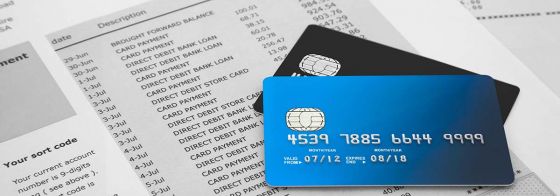What is credit card interest?
You essentially borrow money when using a credit card. Just like most loans, interest is charged on the balance that you owe. In the case of credit cards, you can get round this by repaying the full balance before the due date. We’ll go into more on that shortly.
To put it simply, credit card interest is a charge that you pay for borrowing money, something that you’d most likely want to minimise or eliminate completely.
How are credit card interest rates calculated?

Credit card interest rates are calculated daily, as a percentage of the balance you owe, and is shown as an annual figure, like 9.99% per annum.
To calculate your credit card interest amount, you must first identify your daily interest rate, which is calculated by dividing the annual percentage rate by 365 days. Your daily outstanding balance is then multiplied by the daily interest rate on your credit card. The daily total is added together at the end of each month to identify the total interest due.
When is credit card interest charged?
Most credit card companies calculate interest on a daily basis and add the charges to your account at the end of each statement period, which is usually at the end of each month. You are therefore charged interest on a monthly basis.
Since interest is being calculated every day on your card when you have a balance owning, it is always better to make payments when you are able to, rather than waiting for the “Due Date”. Any payment you make will lower the daily balance and the amount of interest you are charged at the end of the month.
The different types of credit card interest rates

There are different types of interest charges that apply when you use your credit card in different ways. Here’re the main types of interest charges and how they apply.
Purchase interest rate
This is the interest you are charged when you use your credit card for standard purchasing costs, like retail shopping or paying bills online.
Cash advance interest rate
This is the interest rate charged on cash transactions, like when you use your credit card for withdrawing cash from ATMs or buying gift cards. You can avoid this by not using your credit card to withdraw cash, purchase foreign currency or perform international money transfers.
Note that the interest rate is not the only charge associated with making a cash advance – there’s also the cash advance fee. This can be a flat fee or a percentage fee based on how much cash you withdraw. Find out more about cash advances here.
Promotional or introductory interest rates
These are special promotional interest rates – usually lower interest rates – that many credit card companies offer new customers. These are usually only available for a limited time. Standard interest rates applying after the promotional period ends.
Balance transfer rates
As its name suggests, this is the interest rate you’re charged when transferring a balance from an existing credit card to a new card. Any unpaid debt at the end of the balance transfer period typically reverts to the purchase interest rate or the cash advance rate.
Always check the details of the offer before signing up for a balance transfer.
What you need to know when looking for a new credit card
Before signing up for a credit card, it’s important to consider the following, in addition to interest rates:
Interest free period
Some credit cards offer an interest free period when you pay off your account in full before the due date on your statement. This period is usually around 44 or 55 days, but varies between institutions. Spending on your credit card during these interest free periods gives you a way to avoid interest pitfalls.
This interest rate refers to the maximum possible length between the first day of a statement period and the payment due date for that period. ANZ provides an example for its 55 interest free credit card. If your credit statement is from 1 June to 30 June, your repayment will be due on July 25th, which is 55 days after the first day of that statement.
However, it’s important to note that the interest free period is up to 55 days interest free. Not all purchases you make get 55 days interest-free days. It depends on when that purchase was made during that statement period. Using the example above, here are two scenarios of how interest would be calculated with a 55 day interest free period.
- If you made a purchase on 1 June, you’ll get the full 55 days before your bill is due.
- If you made a purchase on 28 June, you’ll have 27 days before your bill is due.
0% interest rate offers.
Some credit cards may come with a promotional 0% interest rate, which may only apply to certain types of transactions, like balance transfers, or on both purchases and balance transfers. This promotional rate is typically offered for a limited period of time, with standard rates applying at the end of the promotional period.
Annual fee
Most credit cards come with an annual fee, which is charged each year. When comparing credit cards, it’s important to take note of and budget for this cost, on top of interest rates.
Other credit card features
Different credit cards may come with additional features such as reward points, which typically act as a way to attract new customers and “offset” the costs of interest charges. It’s important to weight up the value between costs and benefits before deciding to sign up for a credit card.
Compare credit cards
The most important thing to understand is that interest never goes away; it accumulates until you pay off the closing balance of your account. To avoid being hit by massive interest charges, don’t just pay of the minimum amount due every month – pay it off in full.
For more credit card tips, read our article about how to consolidate and pay off credit card debt or how to improve your credit rating by using your credit card responsibly.
Canstar’s credit card comparisons help you work out which product and provider would best suit your needs. Use our free comparison tool to see what will work for you.




Share this article